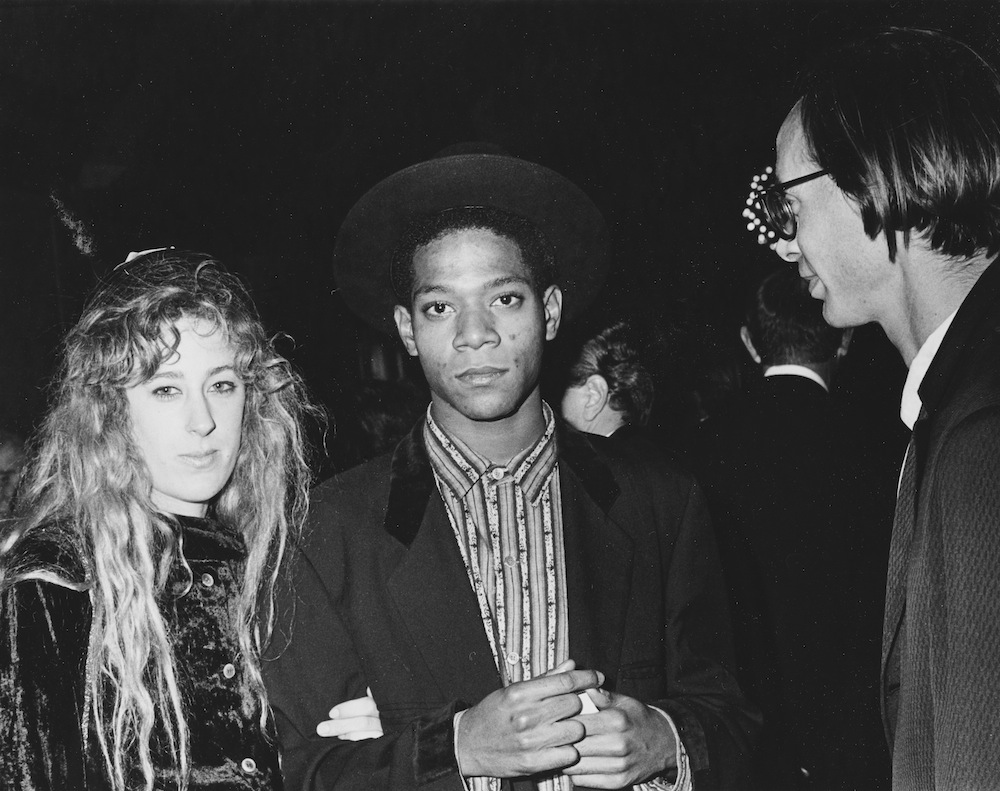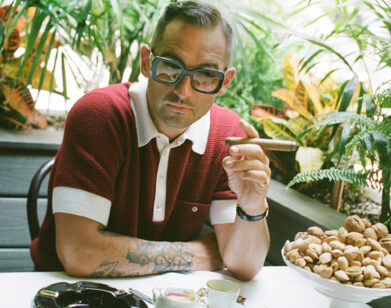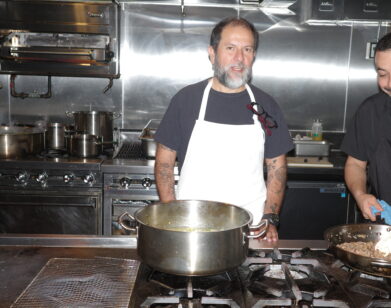Jennifer Goode and Area’s Heydey

ABOVE: JENNIFER GOODE AND JEAN-MICHEL BASQUIAT. PHOTO COURTESY OF JENNIFER GOODE.
“I met him at Area. He did not have to stand in line, because the door people knew him. They would let in anyone that looked cool,” says Jennifer Goode with a laugh. “Jean-Michel [Basquiat] looked cool.” Goode’s two brothers and a friend founded Area, the famed downtown New York nightclub that was open from 1983 to 1987, and Goode worked for the art department at the time. Her job was to find and purchase all of the props and materials that went into the club. “It was non-stop work for all of us to keep the club running, and then in the middle of it, I fell in love with Jean-Michel,” she continues. “I hadn’t had any romantic relationships really for quite a while. And then he came, and clearly he was the one. So I had to try to balance being with him and keeping the parties at the club going—what a life.”
If there was one thing that Lower East Side artists, Wall Street bankers, and city wanderers had in common in the eighties, it was the hope that they would make it past the Area bouncers that weekend. While every six weeks the club underwent a radical makeover with a new theme and corresponding interior—much of which is a credit to Goode, who as “prop girl” was charged with furnishing the visual experience—certain guests were staples, including Andy Warhol and Keith Haring.
Area’s counterculture, colorful crowds, and musical line-up are now synonymous with eighties New York, and in turn, its guests were disproportionally affected by the plagues of the time: AIDS and heroin overdoses. Sadly, this included Basquiat, who passed away due to an overdose in 1988 at age 27. From 1984 to 1987 he was Jennifer Goode’s boyfriend and one of the loves of her life.
Last year we sat down with Goode at B Bar, the popular restaurant and bar in NoHo that she manages. Scattered across its walls are photos from the eighties, and for the first time, the 60-year-old is willing to be interviewed about the Area days and her memories of Basquiat.
LAURA KEMP: Do your employees here know about your exciting past in the night club world?
JENNIFER GOODE: Hah—well, there are these prints on the walls from the Area days, so most people know that I was in the nightclub scene, but it doesn’t come up. I’m kind of the grandmother here; I turned 60 this year, which is really crazy. In my emotional life, I don’t feel 60.
KEMP: Area was founded by your brother, nightclub owner and entrepreneur Eric Goode. How did he come up with the concept? And how did you experience the process?
GOODE: My brothers and friends bicycled around the city for days, looking for the right place to put the club. It was a very serious study for them: an anthropological field trip through town. Eventually they found this space on Hudson Street. From the outside it was impossible to tell that it was 13,000 square feet. The set up was ideal, because the guests had to walk through a long corridor, which naturally allowed them to focus their attention to a new theme installation, which is what we wanted. The hallway would take you to the dance floor, which was also transformed for each theme.
KEMP: Area has become legendary for these themes, props, and impressive installations. What kind of themes can we think of?
GOODE: Oh my god, there were lots of crazy themes and objects. We did a theme called “Carnival” once for which I had to drive to Coney Island and try to find actual carnival rides that would fit in the club. It also led me to a carnival convention in Florida and a place in Pennsylvania that maintained broken down carnival rides. And then we had to find the right people: midgets, acrobats, performers. Another theme would be “Gnarly” for which I had to find dark stuff such as chains and crazy cars. For that, we took a lot from the old movie set of Mad Max that had come out a few years before. For some reason everything always worked out but it was really hectic and kept me busy day and night.
KEMP: And you were the single person in charge of all of this. How were you able to organize all that, without cell phones or internet?
GOODE: Well, I drove a pick-up truck, which helped a lot. After deciding on the items we needed, I’d make a list and have some company checks and cash in my pocket. There was definitely no internet, no ATMs, no cell phones at the time. So to communicate I’d use the pay phones on the street corners, which was a pain because often the booths were unavailable, and of course, when they were available the lines at Area would be in use. So that led to a lot of waiting and trying to get a hold of people. We only had three days to do the actual change. Everything would be thrown out, and had to go back to wherever it came from, so this whole club had to be converted into a whole new theme in this three day period.
KEMP: Was the interior the secret to club Area’s success?
GOODE: Yes, but its success also had to do with the people. I think, during the early and mid-eighties, there was this confluence of people that came to Area that made it so special. Area’s door policy was very much talked about and contributed to its image. It was such a wild mix of characters, which was also very well documented with photography. So we kept these amazing images of this mix of people. And because the environment changed all the time, these images are more interesting than a group of people sitting at a table, night after night.
KEMP: Was it at all possible to find some regularity or a working schedule?
GOODE: Not really, being the prop girl, and also working at the club during events kept me really busy constantly. … And [then] all of a sudden [Basquiat] came and was the one. And being his girlfriend was also very time consuming. But maybe I’m jumping subjects now.
KEMP: I was actually a bit nervous to bring him up in our conversation, so I’m grateful that you just did. He was a big part of your life at the time. Do you remember your first impression of him?
GOODE: I didn’t know who he was. He came in with a group of people and he paid for everybody, which was unheard of. You would see people paying for one person, but you wouldn’t just go to the window and pay for everybody. So of course I was impressed by his generosity, and I wondered who he was. I think I gave him a bottle of champagne, for his friends and him. And somehow that’s how I was introduced to him. I don’t remember the rest of that night. I do remember that not very long after, we had our first date, which was with my mom and I think with my sister. All of us went to see a movie together. My mother and my sister sat separately from us, for some reason. I just noticed that Jean-Michel was nodding out throughout the whole movie. And I was like, “What is he doing?” I didn’t know what nodding out was. I wasn’t really aware of that term. But he was kind of sleeping and awake, sleeping and awake.
KEMP: Do you remember your mom’s impression of him?
GOODE: I think she thought… I don’t know. I remember we walked by a newsstand, and he picked up the New York Post, because he had heard he was on Page Six or something. I think she mentioned that part—maybe she thought he wasn’t that modest about it.
KEMP: Was he a different person in public from how he was when you were alone with him?
GOODE: He didn’t really have a public persona or act very differently. He was shy when going outside, but he also could be really caustic and sarcastic if he thought that people weren’t respecting him or if he thought people were racist. It’s hard for me to describe what he was like. It also depended on who he was with. If he was with collectors or dealers he was a lot more cautious about what he said, more introverted. But we didn’t go out a lot. It seemed to me what he enjoyed the most was working. And he worked every day, all night.
KEMP: Why do you think you were drawn to each other?
GOODE: [pauses] I don’t really know. I think we appreciated some of the same things. I think I was easygoing and down to earth enough to be able to handle him. But I also was the caretaker in that I could smooth things over—the mother and the girlfriend role. I definitely know why I was attracted to him. He was really charismatic and handsome and smart and funny, and he took me on trips and it was really a lot of fun. Why he was attracted to me, I never asked. I don’t know.
KEMP: When did you realize that drugs were a big part of Jean-Michel’s life?
GOODE: Pretty soon after I met him it was apparent. But I was in love. And I was willing at that point to hang out with him and be his girlfriend. And then I started doing drugs right after I met him, so it became a thing we did together. It actually became a big part of our relationship. He didn’t drag me, he cautioned me. He would ask me, “Do you know what this is?” And I said something like, “Don’t worry. I can handle it,” or, “I know what I’m doing.” He wasn’t like, “Help yourself to whatever you want.” … I never blamed him. I fully knew what I was getting into. And yes, I was a little naive, but I wasn’t that naive.
KEMP: Where would you spend most of your time together?
GOODE: We would most often just hang out in his house on Great Jones Street. We would get high in his bedroom upstairs, which was the private place. Only the housekeeper would sometimes come in.
KEMP: I’ve walked passed that loft on Great Jones a couple of times, and it has an official Basquiat plaque now. What did it look like at the time?
GOODE: It was small and loft-like up there. It had a bathroom. And of course it was carpeted in industrial grey because it was the eighties. [laughs] He had a platform and a step going up to his bed, which was also carpeted. And he had a big mission-style bookcase with books. He also had a record player with albums lined up on the floor—a long row of them. And he had a tape recorder for a boombox. He would play tapes. He had a big TV, some small Warhols on the wall, some masks from Mexico. But, most often he would just be on his knees on the carpet—drawing. A big box of crayons and pencils could keep him occupied for hours. The downstairs part of his house was the public place so if anyone was coming over to look at a painting or when it was a business relationship it was always downstairs.
KEMP: B Bar, where you spend your working days, is also right around the block from his old apartment. You walk past it all the time. How does that feel?
GOODE: I don’t think about it a lot. I am not living in the past. I’m living now. We have all moved on, it’s a whole other world and whole other time. Of course I wish he was still here, but I don’t think of it as macabre.
KEMP: You broke up about a year before he passed away. Was that a sudden decision? Or did you just grow apart?
GOODE: I met him in ’84. I think I broke up with him in the beginning of ’87, but I wasn’t over him at all. It was just that at a certain point, I started to realize that I couldn’t continue on in that way. I had to stop doing drugs, and the only way to stop doing drugs was to break up with him. But I was still involved in his life—worrying about him and obsessing about him. I think I was really unhappy. Being addicted to something is not fun, and I really wanted to get out of it and stop it. It’s a difficult thing to do and it took me a while. If you don’t have the heroin, you don’t feel good. And when it’s always on your mind, you are not free. When I broke up with him, he got really angry: he destroyed his room, punched a hole in the wall with his fist, and broke some furniture. I found out later that he had drawn a broken heart with a copyright sign on the wall. And after that, he became more and more reclusive, he became more addicted, his health was declining. It was so painful to watch. Around the same time of our break up, Andy Warhol died as well. l, and many others who knew him, also believe the death of Andy really contributed to that decline. I think the show that he had with Andy, which had such negative reviews, didn’t help. I don’t know why he went down so fast. He had a lot going for him and he was doing what he loved to do and he could make a living off of it. But it wasn’t enough.
KEMP: Going through all of this, from your point of view, did it ever cross your mind to write a memoir or publish a book like Jean-Michel’s other ex-girlfriend Suzanne Mallouk, who wrote Widow Basquiat?
GOODE: I like Suzanne’s book; it’s like little vignettes and it reveals quite a bit. I am now finally thinking I should write a memoir, and I’m making the first steps towards it. But I didn’t have the guts for a long time. It just feels like everyone seems smarter or more opinionated about him than I am. It could be a lack of self-esteem; I was just his girlfriend you know. And in the beginning I always said no to interview requests, so people stopped contacting me. It was just really hard. From the time I left Jean-Michel I could see what was going to happen to him. I knew he was going to die. I still have this old notebook in which I was desperately writing letters to him, trying to tell him he should write a will and think about what would happen if he died. Nobody was advising him about what would would happen to his estate. He didn’t write a will. All his belongings went to his family.
KEMP: So that meant that you didn’t inherit anything?
GOODE: No, I didn’t. He gave me two paintings, one of which he sold to someone else—somebody came in and wanted it. That’s what would happen; he gave me something, made it a special moment, but then sold it to somebody else the next day. And the other one I got from him didn’t get recognized by the Basquiats as mine. [laughs]
An interesting thought is, if I had his child, my life would have been completely different. But I didn’t keep it. I was pregnant and had an abortion. He didn’t put up a big fight about it. I think he would have been fine if we had the baby. He would have been happy and fine. I wasn’t too young. But the situation, the drugs—we weren’t ready.
I tried to get him into a methadone program, which he did start. I brought him there, and he seemed open to it. He went through the psychological test with the psychiatrist and he filled out the paperwork, but then he never showed up again. He might have just tried to placate me or he might have wanted to stop but couldn’t. We’ll never know.
KEMP: But you were able to end your addiction with the help of the methadone program, and you had to do it without him?
GOODE: It would have been impossible for me to keep seeing him and get clean. The temptation would have been really great. I was in therapy during that methadone program, and all I talked about was him. I didn’t really talk about me. It was very painful. You are never someone’s first love when you’re in a relationship with somebody who is abusing: the addiction is. There is no room, no way, to have a real relationship with someone. I was in love with Jean-Michel and it was really hard for me to break up with him. I didn’t do it in a complete way. It dragged out; I wasn’t able to just stop seeing him, but I had to find my way. So, I went into the program, which was a process; I didn’t quit overnight. But when you’re on methadone the effects are not as strong, so taking heroin then feels different. I was still doing it sometimes, so I didn’t fully stop using until December of ‘88. Only after Jean-Michel died I was able to completely stop.
KEMP: What is your perspective on drugs now? And how have you managed to move on so greatly?
GOODE: My kids know that I did drugs. It kind of came up; it’s not like we had a long conversation about it. I’m not anti-drugs, but we really have to do it with moderation, as with anything. There are some things you might just not want to ever try because they are so addicting. You can’t control anybody. So I can only be an example and hope that a little bit rubs off on my children. As for myself, I never really had a plan, and I still have no plan. My concerns have always been to just get through the day, see what comes up, and figure out how to get it all done. Although I do have this ambition to do a handstand—I am working on my handstand. And of course, I still drive a pick-up truck.






